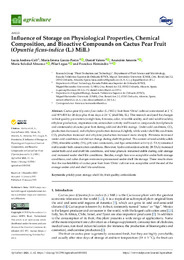Please use this identifier to cite or link to this item:
https://hdl.handle.net/11000/36259Full metadata record
| DC Field | Value | Language |
|---|---|---|
| dc.contributor.author | Almansa Pascual de Riquelme, María Soledad | - |
| dc.contributor.author | Andreu Coll, Lucía | - |
| dc.contributor.author | García Pastor, María Emma | - |
| dc.contributor.author | Valero, Daniel | - |
| dc.contributor.author | Amorós, Asunción | - |
| dc.contributor.author | Legua, Pilar | - |
| dc.contributor.other | Departamentos de la UMH::Biología Aplicada | es_ES |
| dc.date.accessioned | 2025-03-31T14:43:39Z | - |
| dc.date.available | 2025-03-31T14:43:39Z | - |
| dc.date.created | 2021-01 | - |
| dc.identifier.citation | Agriculture Volume 11 Issue 1 | es_ES |
| dc.identifier.issn | 2077-0472 | - |
| dc.identifier.uri | https://hdl.handle.net/11000/36259 | - |
| dc.description.abstract | Cactus pear (Opuntia ficus-indica (L.) Mill.) fruit from ‘Orito’ cultivar were stored at 2 ◦C and 90% RH for 28 days plus three days at 20 ◦C (shelf life, SL). This research analysed the changes in fruit quality parameters (weight loss, firmness, color, titratable acidity, and total soluble solids), ethylene production, respiration rate, antioxidant activity and bioactive compounds (total phenols and carotenoids) of cactus pear fruit during cold and shelf life storage. Under cold conditions, CO2 production decreased, and ethylene production increased slightly, while under shelf life conditions CO2 production increased and ethylene production increased more sharply. Firmness increased under cold conditions and did not change during shelf life period. The content of total soluble solids (TSS), titratable acidity (TA), pH, total carotenoids, and lipo-antioxidant activity (L-TAA) remained stable under both conservation conditions. However, hydro-antioxidant activity (H-TAA) increased under both cold and shelf life conditions, and total phenols remained stable during cold storage and increased under shelf life conditions. Besides, weight loss was acceptable under both storage conditions, and color changes were more pronounced under shelf life storage. These results show that the marketability of cactus pear fruit from ‘Orito’ cultivar was acceptable until the end of the storage under cold and shelf life conditions. | es_ES |
| dc.format | application/pdf | es_ES |
| dc.format.extent | 10 | es_ES |
| dc.language.iso | eng | es_ES |
| dc.publisher | MDPI | es_ES |
| dc.rights | info:eu-repo/semantics/openAccess | es_ES |
| dc.rights | Attribution-NonCommercial-NoDerivatives 4.0 Internacional | * |
| dc.rights.uri | http://creativecommons.org/licenses/by-nc-nd/4.0/ | * |
| dc.subject | prickly pear | es_ES |
| dc.subject | storage | es_ES |
| dc.subject | shelf life | es_ES |
| dc.subject | fruit quality | es_ES |
| dc.subject | antioxidants | es_ES |
| dc.title | Influence of Storage on Physiological Properties, Chemical Composition, and Bioactive Compounds on Cactus Pear Fruit (Opuntia ficus-indica (L.) Mill.) | es_ES |
| dc.type | info:eu-repo/semantics/article | es_ES |
| dc.relation.publisherversion | https://doi.org/10.3390/agriculture11010062 | es_ES |

View/Open:
agriculture-11-00062-v2.pdf
1,13 MB
Adobe PDF
Share:
.png)
